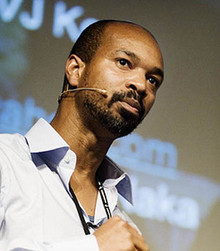
As a group of us observe this technology at a London research gathering of The Smart Lab I can see other apps: a Star Trek moment of literally calling up video to your desktop; and video hyperlinking [linking videos together in the same way as a hyperlink] to extend the timeline of the story - an area I have been researching.
But that's for tomorrow.
Here and now it is video that continues its mushroom cloud expansion online and videojournalism rising upon the crest. It's a far cry from writing in this column almost two years ago when video on broadband was found a tad wanting.
Some interesting observations are unfolding: videojournalism's pervasiveness yields passionate debate in which online you'll find stern voices defining its genus and standards of production and delivery.
But just as digital video (DV) filmmaking has many styles, journalism with video should be afforded creative slack.
It's not a one-size-fits-all. In fact the term videojournalism doesn't do justice to the form, as some practitioners tip into the grey area of DV filmmaking with a strong news undercurrent.
Videojournalist Idar Eduin Krogstad's award-winning Concentra feature The Nightwatch, Travis Fox's various posts from Darfur, and Dimitri Doganis' Siege of Bethlehem are strong films, driven by videojournalism.
Doganis, an original of Channel One TV, the UK's first and only all videojournalism station in 1994, is now a multiple award-winning filmmaker.
He pulled off Siege of Bethlehem, broadcast on BBC 2's Correspondent programme, by filming a sizeable segment with a VX1000 [Sony's entry camera into the digital video market, released mid-1990s], whilst embedded with a special Israeli defence unit.
Does the schism of videojournalism versus filmmaking matter? Not a jot until, that is, you're told online videojournalism comes with an 'instruction manual'.
Learn that by all means - then break the rules: videojournalism online craves more than convention. Trouble is news traditionally doesn’t do creative with a medium 'c'.
Videographer and blogger Peter Ralph commented on my site:
"[It's] unfair to criticise a nascent form for not pushing the envelope obviously, but without a new aesthetic videojournalism is condemned to just looking cheap."
Is innovation the provenance of the big bucks brigade? Ralph has a point.
However, just as the 'Class of '94' and '98 videojournalists have grown, I think the years ahead will yield stronger styles within the construct of creative videojournalism.
That's as opposed to solely adopting television news' lingua franca.
Ralph's comments are a good marker for managers wanting to get ahead of others and also reveal a more poignant observation for our time.
If videojournalism truly wants to flex its muscles you might ask where it's been in one of the hottest of news times, attempting to capture the mess and spill over of the story of the moment, the frenzied nature of this financial crisis.
Traditionally, business reportage has always tested television, which often resorts to typography and motion graphic in reporting packages.
That's mainly because of business' complex language and lack of visual pictures. Videojournalism was meant to fix that.
How? In part by letting videojournalists embed the story and creatively working the construct.
It's all in the Ps: prepare the story, the location, the camera, and interviews; and then prepare for the unexpected to tell the story and go.
Channel One's management called it the 'gang of four' in which videojournalists were daily let off the news belt to work on in-depth stories, effectively acting like a newspaper beat reporter.
Meanwhile, what is discernible online is video's growing televisual experience: many more affordable HD cameras and larger pixel viewing experiences, such as Vimeo.
It poses an interesting question, as to how viewers will increasingly tend to discriminate online. A compelling video about a riot will still grab eyeballs on a screen, the size of mobile phone, but when the other side has it on HD on a larger screen, it's a different story.
How about online shows looking to migrate from the web to television? Not exactly new. But BBC Switch and sites like Filminute - a show built around strong user-generated content from accomplished filmmakers - play well to the 'triple play' concept: mobile, TV, online.
I recall sitting with the then commissioner of BBC 3, Stuart Murphy, in 2002 looking at a web-to-tv idea. Was it too early? Then just as now, some of my colleagues engaged in the perennial sport of bemoaning television.
Television isn't dead, we would later say. It's the content and it's online where we can continue to incubate and generate innovative ideas.
What do you reckon to Bluetooth television? Naah...
David Dunkley Gyimah is an international award-winning videojournalist and a jury member at the 2008 International Video Journalism Awards. He's been a videojournalism trainer since 1994 and broadcaster since 1987. He's a senior lecturer and Phd Student researching the Outernet and blogs at viewmag.blogspot.com on videojournalism and innovation, as well as publishing viewmagazine.tv. He was recently shortlisted as a gamechanger at Wemedia.
Free daily newsletter
If you like our news and feature articles, you can sign up to receive our free daily (Mon-Fri) email newsletter (mobile friendly).
Related articles
- 38 mojo apps from BBC trainer Marc Blank-Settle
- How to create viral news videos
- What will be the lasting legacy of the pandemic on the digital media world?
- James Hewes, CEO of FIPP, on the legacy of the pandemic on digital media
- The NYT bets on edgy comedians and vloggers to make its opinion videos go viral









